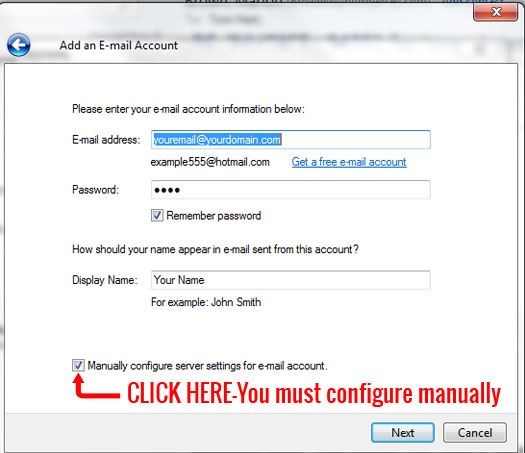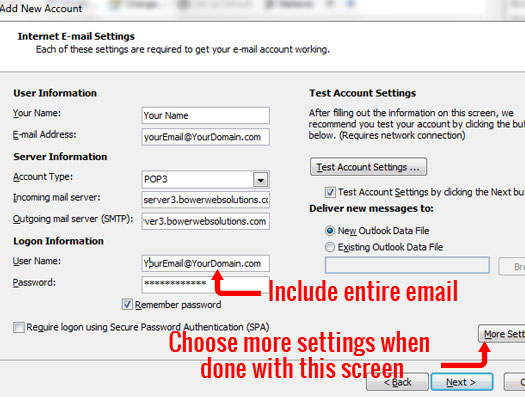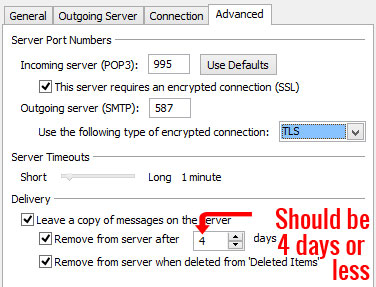Configure Email in Outlook 2016 & Earlier & Outlook Express
Applies to:
Difficulty Level:
Medium
Time Needed:
10 minutes
Tools Needed:
Microsoft Outlook
Introduction
This tutorial is provided as a courtesy to our hosting customers to help you configure your Microsoft Outlook 2003, 2007, 2010, 2013 and 2016 or Outlook Express software to work with Bower Web Solutions email.
Outlook is part of the Microsoft Office package.
Outlook Express came as part of pre-installed programs on most Windows ME and XP and earlier Windows computers and was replaced by Live Mail in Vista and Windows 7 & 8 and the Mail client in Windows 10.
Though Outlook 365 also uses exactly the same settings, the setup is different enough that we have created an Outlook for office 365 tutorial.
IT Professionals and Expert Set Up
If you have doubts about your expertise take the time to use the complete setup instructions below:
- Use manual configuration for POP3 email. Our servers limit storage making IMAP impracticable and autoconfig uses IMAP – we do offer other email options if full synchronization is required. Contact us for more information.
- server3.bowerwebsolutions.com for both incoming and outgoing servers.
- Username is complete email address (including domain).
- Secure Password Authentication (SPA) logon is not required.
- Outgoing server requires authentication.
- Incoming server should be 995 with an encrypted connection required.
- Outgoing server should be 587 with auto encryption.
- IMPORTANT: Reduce the time messages are left on the server to slightly longer than the back up period. Check Remove from server when deleted from deleted items and verify that user understands how this works – Details / additional information below.
Requirements
Before you start, be sure you have these pieces of information available:
- Your email address ( example: someone@somewhere.com )
- Your email password (NOTE: passwords are case-sensitive and must be entered exactly as provided)
How to Configure Microsoft Outlook (& Outlook Express)
This tutorial uses screenshots from Outlook 2010. Different versions of Outlook will see slight differences.
While we try our best to assist our customers, assistance with third-party software can not be supported completely by Bower Web Solutions.
Open Microsoft Outlook or Outlook Express.
- Open Microsoft Outlook or Outlook Express.
If this is the first time you’ve opened Outlook or Outlook Express, you will be prompted to create an email account if you have not used Outlook before.
If you already have an email account in Outlook:
Outlook 2010 and later. Choose File in the top left corner. Click on the ‘Account settings’ box in the center and then click on the ‘Account Settings: Add or remove accounts or change existing accounts’ box that appears. In some versions you need to click directly on the little triangle shaped arrow below ‘Account Settings’.
Outlook Express and Outlook 2007 and older . Mouse over Tools in the main navigation bar and click on accounts. - Email account is normally selected. If not, choose email account. Click next.
- Check manually configure server setting for email account and click next.

Note that automatically configuring will set up your account incorrectly and cause disk space issues in the future.
You must set up your account manually for it to work properly.
Outlook 2013 may not have the “Remember Password” checkbox here, but you will have it later. - Enter your Account Settings.

My incoming mail server is a POP server.
Incoming mail server and outgoing mail server should be server3.bowerwebsolutions.com.
Email username is your complete email address (i.e. YourEmail@yourDomain.com, not just YourEmail).
Passwords are case sensitive and must be exactly right (we know we don’t need to say this, but incorrect passwords are the most common problem. If you are unsure, check to make sure you can login using webmail).
Check ‘remember password’.
Secure Password Authentication (SPA) logon is not required. - Check the box for ‘My outgoing server requires authentication’.
If you already have an email account and want the new emails to be mixed with the old select and existing outlook data file. If you want to keep them separate then create a new outlook data file.
- But you are not done. Click “More Settings”.
Click on the ‘Outgoing Server‘ tab.
Check ‘My outgoing Server requires authentication’ and
Check ‘Use same settings as incoming server.’  Click on the ‘Advanced’ tab.
Click on the ‘Advanced’ tab.
Check “This server requires an encrypted connection (SSL).
The incoming server should change to 995 (change if it does not!)
Check that the outgoing server (SMTP) is 587 and type of Encryption is ‘TLS’ encryption (if available; use auto if TLS is not available; note that SSL/TLS and STARTTLS are different from standard TLS and should not be selected).- Make sure you are not leaving messages on the server (for too long).
Explanation: Once you have downloaded the messages onto your computer they will be saved on your computer. Leaving them on the server takes up resources and risks filling up your e-mail account or even the space allocated for the entire website. By default, Outlook should not leave messages on the server. However, since leaving messages on the server will quickly cause your account on the server to fill up, we highly recommend you take a second to check.
If you check messages from multiple devices you need to leave messages on the server long enough for the other devices to sync.
Uncheck the box “Leave a copy of messages on the server” or if you leave “Leave a copy of messages on the server” checked, change the number next to “Remove from server after” to 1 to 7 days to give your computer time to back up and/or to get the messages onto other computers
AND select the box to remove from server when deleted from deleted messages if checking does not uncheck ‘remove from server after’. Deleting when deleted is nice to have, but pop email will fill up most server accounts quickly if it’s all not removed after several days.
*Note that email accounts often become full from a few huge email attachments such as pictures, videos or documents. By checking ‘remove from server when deleted from deleted message’, you can save large attachment somewhere else on your computer and then delete the email and empty the deleted folder in Outlook to free up the space on the server. Deleting large emails also improves Outlook performance. - Click the OK button>Click the Next button. >Click the Finish button.
- Outlook should by default send a test message and give you a ‘Congratulations. All tests are completed successfully.
Click Close to continue .’>Click the Finish button. Click Close. - If you don’t have a successful test: If you haven’t already, check to make sure you can log in using webmail.
- Other common problems include not having the full email address, not having the correct servers and not using port 587. Once you’ve made changes try testing again.
